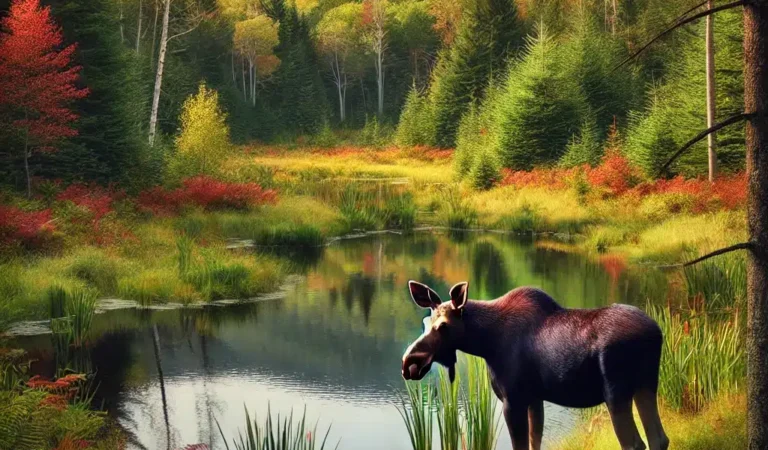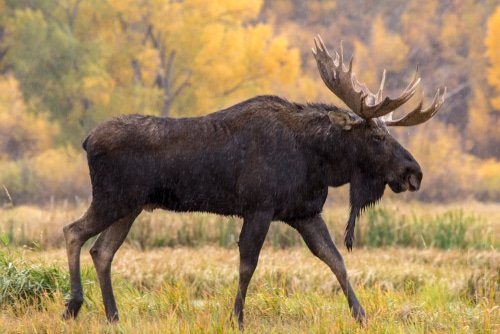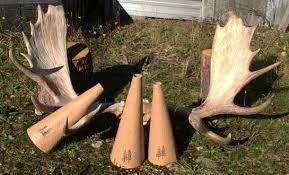Imagine sinking your teeth into a perfectly grilled steak – tender, juicy, and bursting with rich, earthy flavors. What if I told you this wasn’t your average beef but a prized cut of wild moose? How much do you know about moose meat? Read on.
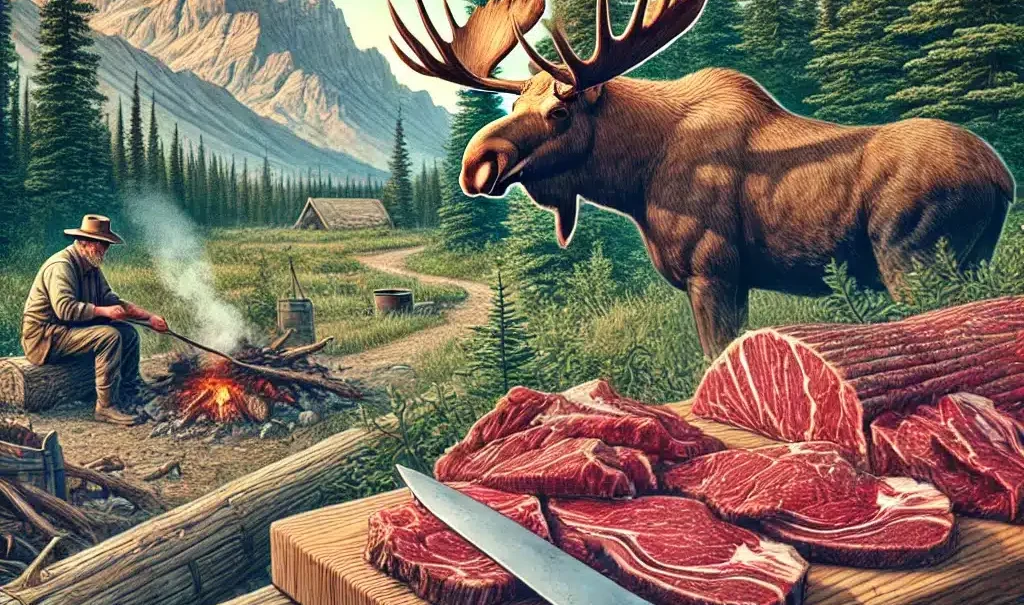
In big game hunting and wild cuisine, few experiences rival the excitement of pursuing a majestic moose through North America’s rugged wilderness. But for many, the adventure doesn’t end with the hunt. The real prize lies in the bounty of lean, flavorful meat that a single moose can provide.
Yet, a cloud of mystery often surrounds this formidable forest dweller’s culinary potential. Can you eat moose? Is moose meat good to eat, or is it too gamey? Do people enjoy dining on this massive mammal?
In this comprehensive guide, we’ll journey from the dense forests where moose roam to the sizzling skillets of adventurous chefs. We’ll explore the art of moose hunting, uncover the nutritional goldmine of moose meat, and delve into expert techniques for transforming this wild game into mouthwatering dishes that impress even the most discerning palates.
Whether you’re a seasoned hunter looking to make the most of your harvest, a curious foodie eager to expand your culinary horizons, or simply someone intrigued by eating moose, this blog post is your ultimate resource. So grab your hunting rifle or your fork – it’s time to discover why moose meat is quickly becoming the new darling of the sustainable food movement.
Moose Hunting Basics
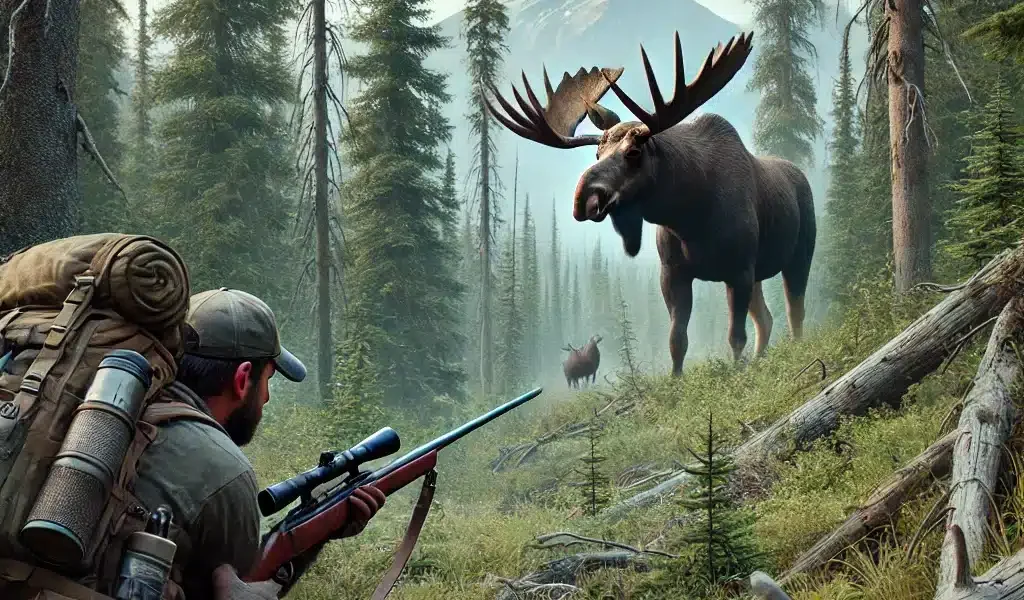
Understanding the fundamentals is crucial for those new to hunting or even seasoned hunters looking to refine their skills. Let’s break down the key aspects of a successful moose hunt.
Where to Hunt Moose
Moose are found in the northern regions of North America, including Alaska, Canada, and parts of the northern United States. They prefer forested areas with abundant vegetation and access to water. Some prime hunting locations include:
Alaska: Known for its high moose population, especially in the interior regions.
Maine: The northeastern state with the highest moose population in the contiguous U.S.
Minnesota: Particularly in the northeastern part of the state.
Canadian provinces: Ontario, Quebec, British Columbia, and Newfoundland are popular for hunting.
When selecting a hunting spot, look for areas with young forest growth, wetlands, and recent logging activity, as these provide ideal moose habitat.
When to Hunt Moose
Timing is crucial in hunting. The best time to hunt varies by region but generally falls within these periods:
Early Fall (September to October): This is typically the peak of the moose rut (mating season), when bulls are most active and responsive to calls.
Late Fall (November): As temperatures drop, moose become more active during daylight hours.
Winter (in some regions): Some areas allow winter hunting, which can be challenging but rewarding.
Always check local regulations, as hunting seasons vary significantly between states and provinces.
Necessary Equipment and Permits

Before heading out on your moose hunt, ensure you have the following:
Hunting License and Tags: Obtain all required permits and tags for your chosen hunting area.
Proper Firearm: For ethical and effective hunting, a high-powered rifle (typically .30 caliber or larger) is recommended.
Appropriate Clothing: Dress in layers and bring waterproof gear. Camouflage or earth-toned clothing is advisable.
Navigation Tools: Compass, GPS, and maps of the area.
Calling Equipment: A moose call can be highly effective during rutting season.
Field Dressing Kit: Include knives, game bags, and rope for harvest processing.
Emergency Supplies: First-aid kit, fire-starting materials, and extra food and water.
Remember, hunting often involves remote locations and challenging terrain. Always prioritize safety and be prepared for varying weather conditions and extended time in the wilderness.
With these basics in mind, you’re well on your way to planning a successful moose hunt. But the adventure doesn’t end with bringing down your quarry. In the next section, we’ll address a question likely on the minds of many first-time moose hunters:
Is Moose Wild Game Meat Edible?
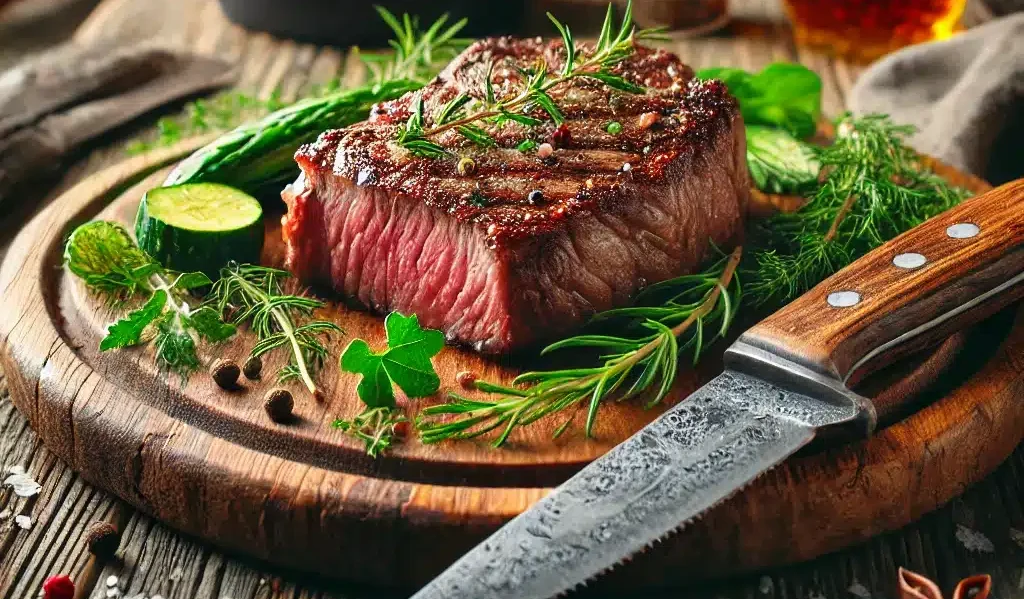
Addressing the question: “Can you eat moose?”
The simple answer is yes, you can eat moose. Moose meat has been a staple food source for indigenous peoples in North America and northern Europe for thousands of years. Today, it’s enjoyed by hunters, food enthusiasts, and health-conscious consumers alike.
Moose meat is edible and prized for its flavor and nutritional value. Every part of the moose – from its tender backstrap to its nutrient-rich organs – can be utilized in various culinary applications.
Nutritional benefits of moose meat (ground meat)
Moose meat is a nutritional powerhouse, offering several advantages over conventional meats:
High protein: Moose meat is exceptionally lean and contains more protein per ounce than beef, pork, or chicken.
Low in fat: With less than 1% fat content, moose meat is among the leanest red meats available.
Rich in vitamins and minerals: Moose meat is an excellent source of:
Iron: Essential for healthy blood cells
B vitamins: Important for energy metabolism
Zinc: Supports immune function
Selenium: A powerful antioxidant
Omega-3 fatty acids: While not as high as in fish, moose meat contains more omega-3s than domestic livestock due to their wild diet.
Low in calories: A 100g serving of moose meat contains approximately 100-110 calories, making it a great option for those watching their calorie intake.
Sustainability of moose as a food source
Eating moose meat aligns well with sustainable food practices:
Wild-sourced: Moose are not farmed, eliminating concerns about antibiotics, hormones, or intensive farming practices.
Natural diet: Moose feed on various plants in their natural habitat, resulting in meat-free from artificial additives.
Land use: Hunting wild moose doesn’t require dedicated farmland, preserving natural ecosystems.
Population control: Regulated hunting helps manage moose populations, preventing overgrazing and maintaining ecological balance.
Low carbon footprint: Wild moose don’t contribute to greenhouse gas emissions like livestock farming does.
Locally sourced: It’s a local meat option for moose country residents.
It’s important to note that while moose meat is sustainable, it should be harvested responsibly. Always follow local hunting regulations designed to maintain healthy moose populations.
Now that we’ve established that moose is edible and nutritious, you might wonder about its taste. In the next section, we’ll delve into the flavor profile of moose meat and address a common concern: “Is moose meat gamey?”
The Taste of Bull Moose Meat
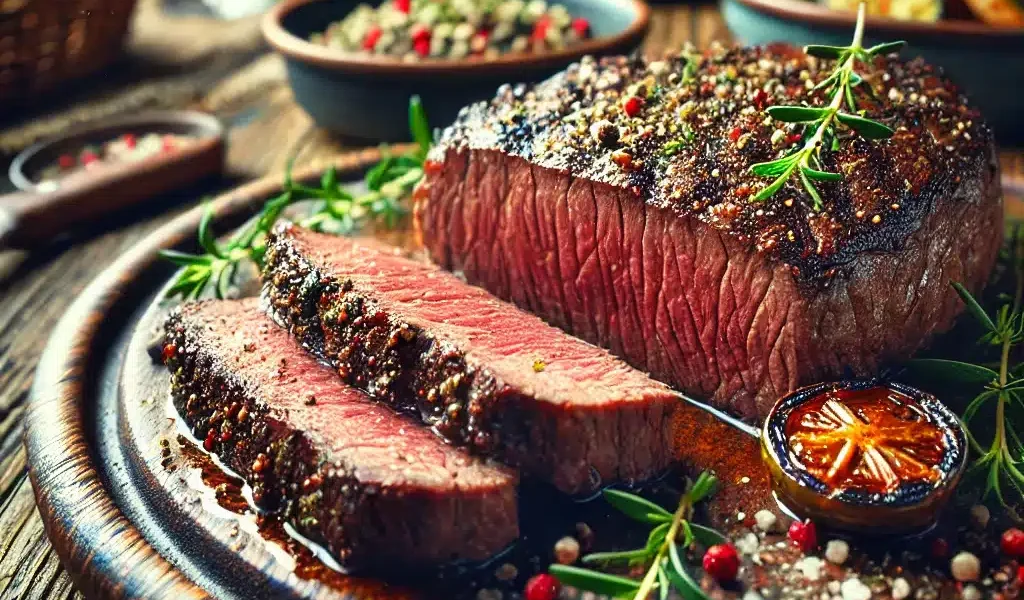
Describing moose meat flavor
Moose meat offers a unique and often surprising flavor profile, with the moose taste setting it apart from domestic meats and other game animals. Here’s what you can expect:
Rich and flavorful: Moose meat has a deep, rich taste that’s often described as more flavorful than beef.
Slightly sweet: Some detect a subtle sweetness, especially in younger animals.
Beef-like but distinct: While comparable to beef, moose has its character – often described as earthy or slightly mineral.
Tender when prepared correctly: Despite its leanness, moose meat can be remarkably tender, especially cuts like the tenderloin or sirloin.
Addressing “Is moose meat gamey?”
The term “gamey” often carries negative connotations but is not necessarily bad. Here’s what you need to know:
Mild game flavor: Compared to other wild meats like venison or elk, moose is generally considered to have a milder game flavor.
Diet affects taste: A moose’s diet of leaves, twigs, and aquatic vegetation contributes to its unique flavor. Moose that feed on willows tend to have a milder taste than those eating primarily pine or spruce.
Meat taste comparison: The meat taste of moose is unique and often compared to other game meats like deer and elk. Due to its diet and lifestyle, moose has a distinct flavor.
Age matters: Younger moose typically have a milder flavor than older bulls, especially during mating season.
Proper field dressing: Quick and clean field dressing reduces the potential for strong flavors.
Cooking methods: How you prepare moose meat greatly affects its “gaminess.” Proper marinating and cooking techniques can enhance the meat’s natural flavors while minimizing overly wild taste.
Comparing moose to other wild game meats
To give you a better idea of where moose fits in the spectrum of game meats:
Venison (deer): Moose is generally milder and less “gamey” than venison.
Elk: Moose and elk are often compared, with moose slightly richer in flavor.
Bison: Moose is leaner than bison but shares a similar richness in taste.
Bear: Moose is considerably milder and more beef-like than the often strong-flavored bear meat.
Wild boar: Moose lacks the distinct “porkiness” of wild boar and is generally leaner.
It’s worth noting that individual tastes vary, and what one person considers “gamey” might be perfectly palatable or even delicious to another. Many people who claim not to like game meat enjoy moose due to its milder flavor profile.
Proper preparation and cooking are key to fully appreciating moose meat. In the next section, we’ll explore how to bring out the best in your moose meat, from choosing the right cuts to mastering cooking techniques that enhance its natural flavors while minimizing any unwanted gaminess.
Preparing and Cooking Moose Meat
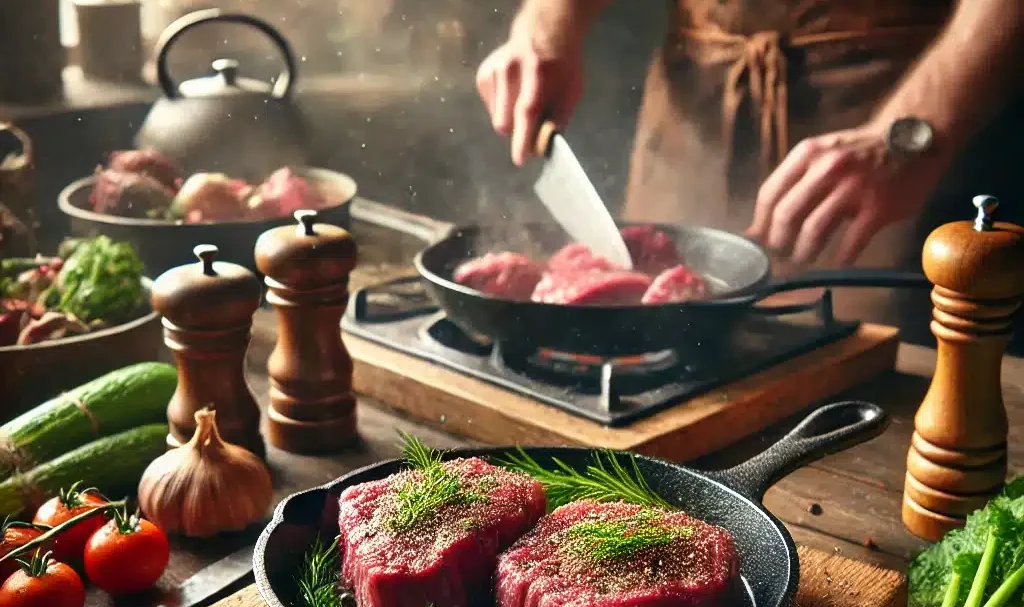
Popular cuts and their uses, including moose steaks
Like beef, different parts of the moose are suited for various cooking methods:
Backstrap (loin): Often considered the prime cut, excellent for steaks or roasts, including moose steaks.
Sirloin and rump: Great for steaks, stir-fries, or cubed for stews.
Shoulder: Ideal for slow-cooking methods like braising or pot roasts.
Ribs: Can be smoked or slow-cooked for tender, flavorful meat.
Ground moose is versatile for burgers, meatballs, or as a leaner substitute in recipes calling for ground beef.
Proper butchering techniques are essential for preparing high-quality cuts like porterhouse steaks, ensuring optimal flavor and presentation.
Cooking methods for different cuts
To bring out the best in moose meat:
Grilling: Best for tender cuts like backstrap or sirloin. Cook to medium-rare for optimal tenderness and flavor.
Roasting is ideal for larger cuts. Use a low temperature (around 300°F/150°C) to prevent the lean meat from drying out.
Braising: Perfect for tougher cuts like shoulder or neck. Slow-cook in liquid to tenderize the meat.
Stir-frying: Thinly sliced sirloin or rump works well for quick, high-heat cooking.
Smoking: Ribs or roasts can be smoked for added flavor depth.
Slow-cooking: An excellent method for making stews, chilis, or pot roasts. Tougher cuts of moose meat are often used as stew meat.
Tips for reducing gamey flavor
If you’re concerned about gaminess, try these techniques:
Marinating: Soak the meat in a marinade containing acidic ingredients like vinegar or citrus juice to help tenderize and mellow the flavor.
Trimming fat: Moose fat can carry stronger flavors, so trim excess fat before cooking.
Using bold flavors: To complement its natural taste, pair moose with strong flavors like garlic, juniper berries, or robust herbs.
Aging: Properly aged moose meat often has a milder flavor. If possible, age the meat in a controlled environment for 7-14 days.
Avoid overcooking: If overcooked, moose meat can toughen and intensify in flavor. Aim for medium-rare to medium doneness for most cuts.
Soaking in milk: Some hunters swear by soaking moose meat in milk overnight to reduce gaminess.
Remember, cooking moose meat is an art that improves with practice. Don’t be afraid to experiment with different seasonings and cooking methods to find what you enjoy most.
Moose Organs and Other Edible Parts
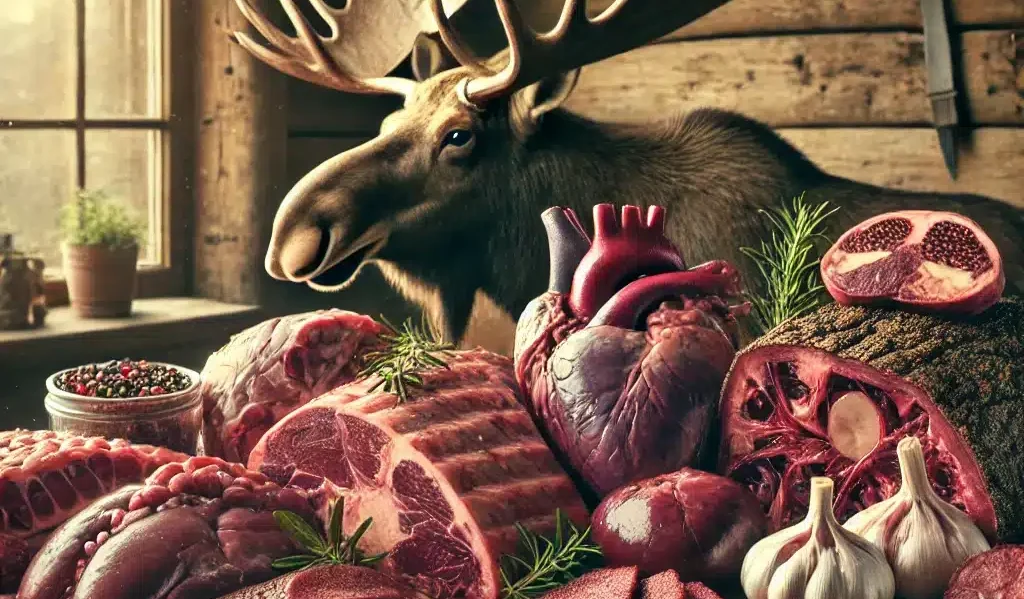
Edible organs (liver, heart, etc.)
While many hunters focus on the prime cuts, moose organs offer unique flavors and exceptional nutritional value:
Liver: Rich in iron and vitamins, moose liver is prized for its tender texture and mild flavor compared to beef liver.
Heart: Lean and protein-rich, moose heart has a texture similar to a firm steak.
Kidneys: These can be prepared similarly to beef kidneys, often used in stews or pies.
Tongue: Though often overlooked, moose tongue can be tender and flavorful when properly prepared.
Bone marrow: Rich and buttery, it’s a delicacy in many cultures.
Traditional uses of moose organs
Indigenous peoples have long valued moose organs for both culinary and medicinal purposes:
Liver: Often eaten raw or lightly cooked immediately after the hunt for its high vitamin content.
Brain: Traditionally used for tanning hides and occasionally consumed.
Intestines: Cleaned thoroughly and used as natural casings for sausages.
Blood: Used in traditional blood sausages or soups.
Tripe (stomach lining): Cleaned and slow-cooked in soups or stews.
Nutritional benefits of organ meat
Organ meats, often called “offal,” are nutritional powerhouses:
Liver: Extremely high in vitamin A, B vitamins, iron, and copper.
Heart: Rich in CoQ10, an important antioxidant, and a good source of B vitamins.
Kidneys: High in B12 and riboflavin.
Bone marrow: Contains collagen and conjugated linoleic acid, which are beneficial for joint and skin health.
When handling and preparing organ meats, it’s crucial to ensure they’re fresh and properly cleaned. If you’re unsure about the safety or quality of the organs, it’s best to consult with an experienced hunter or butcher.
Moose Meat in Different Cultures
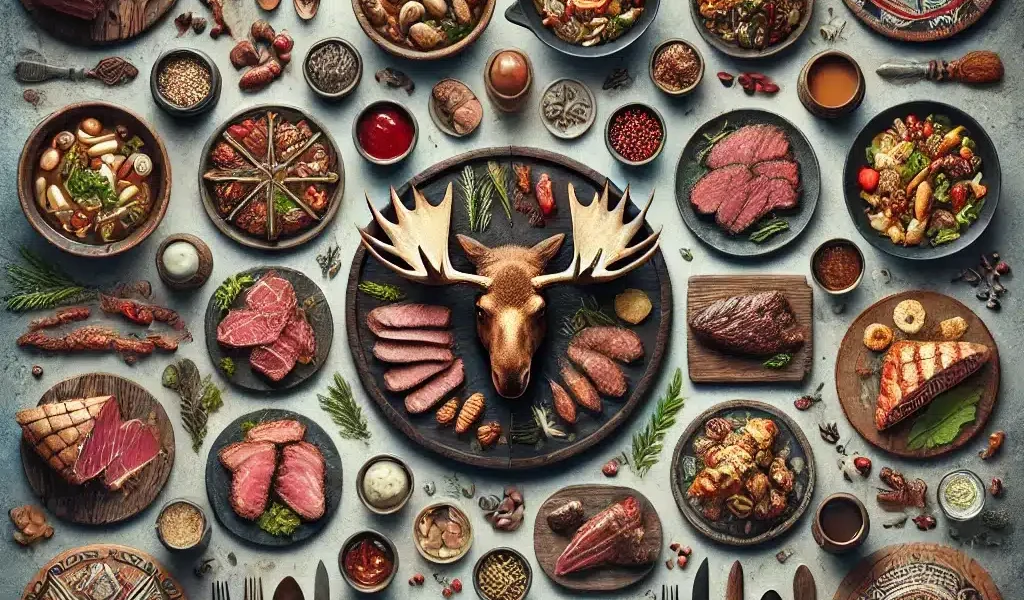
Traditional uses by Indigenous peoples
Indigenous communities across North America and northern Europe have long relied on moose as a vital food source:
Native American tribes: Many tribes, particularly in Alaska and Canada, have traditionally used every part of the moose. The Athabascan people, for example, are known for their moose nose soup, which is considered a delicacy.
First Nations: In Canada, First Nations peoples have a rich moose hunting and preparation tradition. Moose meat is often dried or smoked for preservation.
Sami people: The indigenous people of Scandinavia have traditionally hunted moose and incorporated the meat into their cuisine, often preparing it in stews or drying it for winter use.
Modern culinary applications
As interest in game meats has grown, chefs and home cooks have found innovative ways to incorporate moose into modern cuisine:
Gourmet restaurants: High-end establishments, particularly in regions where moose is native, often feature moose dishes as seasonal specialties.
Artisanal products: Moose jerky, sausages, and pâtés have gained popularity among food enthusiasts.
Health-focused diets: Moose meat’s lean, protein-rich nature makes it attractive for paleo and other health-conscious diets.
Moose meat in various cuisines
While most commonly associated with North American and Nordic cuisines, moose meat has found its way into diverse culinary traditions:
Canadian cuisine: Moose meat pies, stews, and roasts are traditional Canadian dishes, especially in rural areas.
Alaskan cuisine: Moose is a staple in many households, used in everything from burgers to stir-fries.
Nordic cuisine: In countries like Sweden and Finland, moose meat is used in traditional dishes like moose meatballs or moose steak with lingonberry sauce.
Fusion cuisine: Innovative chefs have incorporated moose into dishes from other culinary traditions, such as moose tacos or moose meat in Asian-style stir-fries.
As we’ve seen, moose meat is versatile enough to be incorporated into various culinary traditions. Its rich flavor and lean profile make it an excellent choice for those looking to expand their culinary horizons while enjoying a sustainable, healthy protein source.
FAQs About Eating Moose
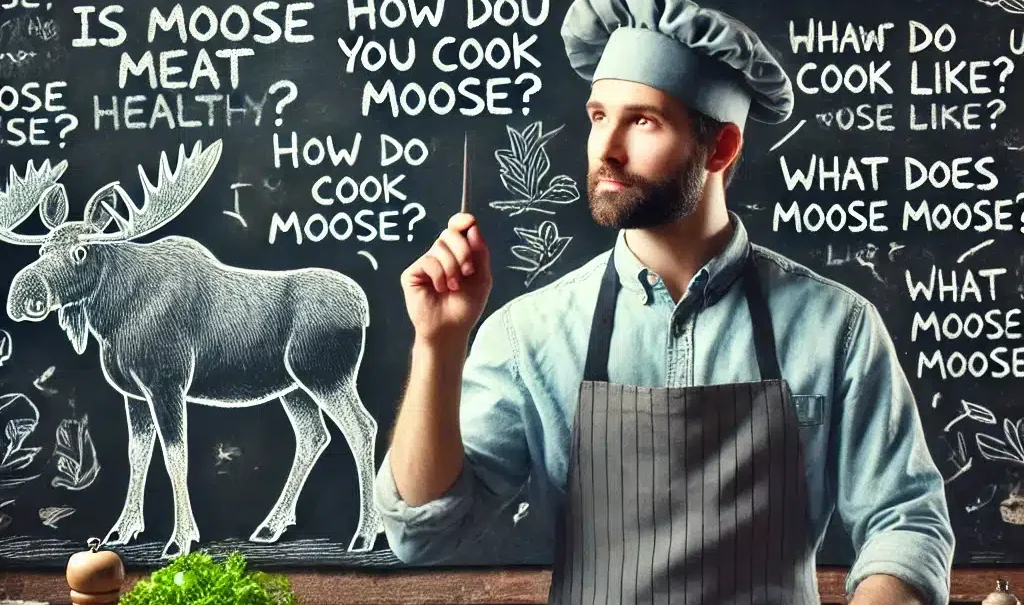
To address some common questions and concerns about consuming moose meat:
Q: Do people eat moose?
Yes, people do eat moose. It’s a popular game meat in regions where moose are native, such as parts of North America and Northern Europe. Hunters, indigenous communities, and food enthusiasts enjoy moose meat for its flavor and nutritional benefits.
Q: What is moose meat like?
Moose meat is similar to beef but with its distinct characteristics:
Flavor: Rich and slightly sweet, often described as beef-like but with a unique wild taste
Texture: Generally tender when properly prepared, despite being very lean
Appearance: Dark red, darker than beef
Q: Are moose good to eat?
Moose are considered excellent to eat for several reasons:
Nutritional value: High in protein, low in fat, and rich in vitamins and minerals
Taste: Many people enjoy its rich, distinctive flavor
Sustainability: Wild-sourced meat has a lower environmental impact than farmed livestock
Q: Is moose meat gamey?
The “gaminess” of moose meat can vary:
Generally considered less gamey than other wild meats like venison
Flavor can be affected by the animal’s diet, age, and how it’s prepared
Proper field dressing and cooking techniques can minimize any strong flavors
Q: How do you cook moose meat?
Moose can be cooked in various ways:
Tender cuts (like loin) are excellent grilled or pan-seared
Tougher cuts benefit from slow cooking methods like braising or stewing
Ground moose can be used similarly to ground beef in burgers, meatballs, or chili
Q: Is it safe to eat moose meat?
When properly handled and cooked, moose meat is safe to eat:
Always ensure the meat comes from a legal, regulated hunt
Proper field dressing and cooling are crucial for food safety
Cook to appropriate temperatures to eliminate any potential parasites
Q: Can you eat moose meat raw?
While some traditional cultures may consume raw moose meat, it’s generally not recommended:
Raw meat can contain parasites or bacteria
Cooking to appropriate temperatures ensures safety
If you wish to eat moose meat rare, it’s best to freeze it for a period first to kill potential parasites
Q: What parts of a moose can you eat?
Most parts of a moose are edible:
Prime cuts like loin, sirloin, and rump are the most popular
Organs such as liver, heart, and kidneys are nutritious and enjoyed by many
Even parts like the nose and tongue are considered delicacies in some cultures
Q: How does moose meat compare nutritionally to beef?
Compared to beef, moose meat is:
Lower in fat
Higher in protein
Rich in iron and B vitamins
Lower in calories

As we’ve explored throughout this comprehensive guide, moose meat offers a unique and rewarding culinary experience that goes far beyond mere sustenance. Let’s recap the key points we’ve covered:
Recap of key points
Edibility and Nutrition: Moose meat is not only edible but highly nutritious. It’s an excellent source of lean protein, vitamins, and minerals, making it a healthy alternative to conventional meats.
Flavor Profile: With its rich, slightly sweet taste, moose meat offers a unique flavor that many find superior to beef. While it can have a mild game taste, it’s generally considered less gamey than other wild meats.
Versatility in Cooking: From grilling prime cuts to slow-cooking tougher pieces, moose meat can be prepared in numerous ways, fitting into various cuisines and cooking styles.
Cultural Significance: Moose has been a staple food for indigenous peoples for thousands of years and is a part of many culinary traditions.
Sustainability: Like wild game meat, moose offers an environmentally friendly protein source when hunted responsibly and according to local regulations.
Organ Meats: Often overlooked, moose organs provide additional nutritional benefits and culinary opportunities for the adventurous eater.
Encouragement to try moose meat
We encourage you to try moose meat. Whether you’re a hunter looking to make the most of your harvest or a culinary enthusiast seeking new flavors, it offers a rewarding experience.
Remember that preparation is key. If you’re new to cooking moose, start with familiar recipes and cooking methods, gradually experimenting as you become more comfortable with its unique characteristics. Don’t be afraid to ask for advice from experienced hunters or butchers specializing in game meats.
Moose can be an excellent introduction for those concerned about the gamey flavor often associated with wild meats. Its milder taste compared to other game animals makes it more approachable for those accustomed to domestic meats.
Lastly, eating moose meat is a sustainable food practice that connects you more closely to the natural world and the food on your plate. It’s a choice that can be both environmentally conscious and gastronomically satisfying.
Whether you’re savoring a moose steak grilled to perfection, enjoying a hearty moose stew on a cold winter’s night, or exploring traditional preparations of moose organs, you’re partaking in a culinary tradition that spans cultures and generations. So why not embark on your moose meat adventure? Your taste buds – and possibly your health – will thank you.


